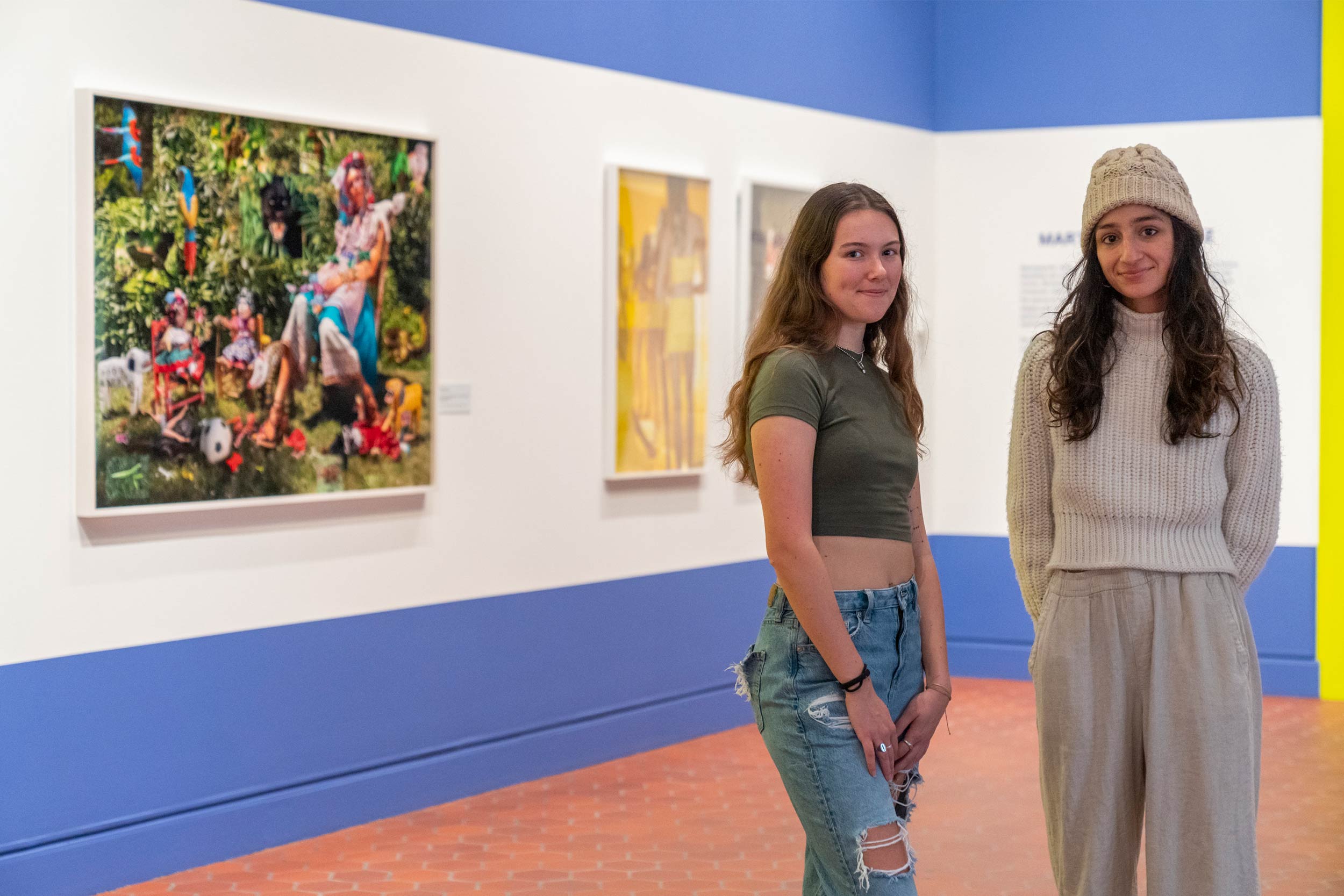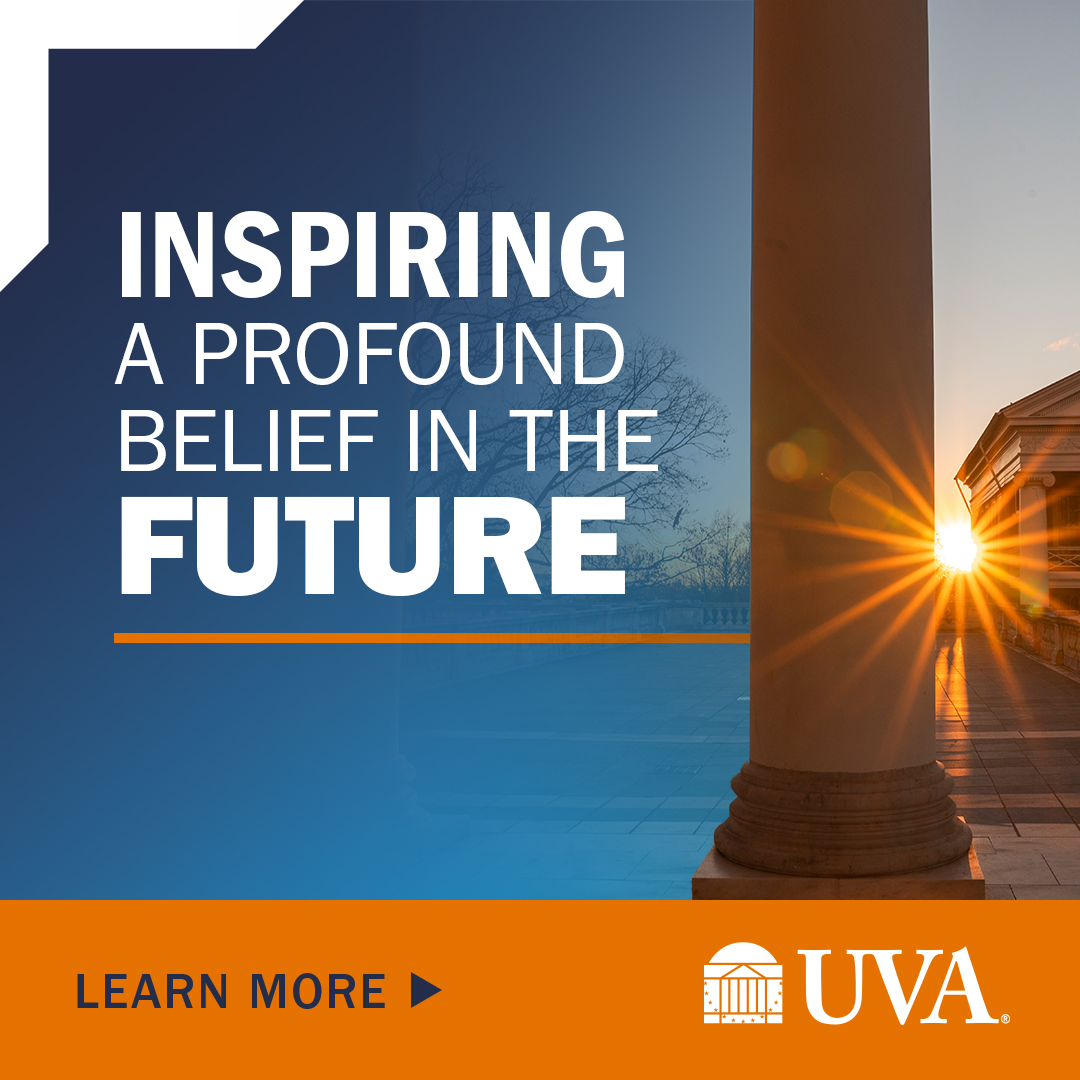The direct gazes of the portrait subjects and vibrant colors of the photographs caught the attention of two museum visitors, University of Virginia students who are photographers themselves.
Photography Exhibit Turns Female Stereotypes on Their Heads

Tokie Rome-Taylor depicts Black girls dressed to reimagine an alternative past of beauty, wisdom and power.
Ava Proehl and Kate MacArthur, who both work on the UVA student newspaper, the Cavalier Daily, took a break from their studies to view The Fralin Museum of Art’s “Power Play: Reimagining Representation in Contemporary Photography.” The exhibit displays selected works of five photographers from women’s perspectives: Sarah Maple, Tokie Rome-Taylor, Cara Romero, Martine Gutierrez and Wendy Red Star.
Maple puts Disney princesses in contemporary settings as modern women. Romero’s large portraits show Indigenous women arranged like American Girl dolls in their packages. Tokie Rome-Taylor depicts Black girls dressed to reimagine an alternative past of beauty, wisdom and power. Gutierrez experiments with natural and artificial settings. Red Star shows herself in decorative Native dress with different backgrounds.
“The exhibit is attention-grabbing in a powerful way with these unique stories,” Proehl, a third-year Commerce School student, said. “It calls attention to recognizing women. They’re saying, ‘We’ve faced oppression, we’ve faced being silenced, but we are here, and our stories need to be told.’”

MacArthur, a second-year student, agreed, saying the gazes of the women in many of the portraits are “defiant.”
“They are making direct eye contact and showing they’re not afraid,” said MacArthur, who plans to major in global environments and sustainability. “And they are hung at eye level, so you really get that direct eye contact.”
Proehl and MacArthur are both self-taught photographers. Proehl prefers sports photography; MacArthur, natural landscapes and human-made ruins. Both get most of their jobs taking portraits, however, from high school senior pictures to college fraternity and sorority formals to club teams.
The photos of the Fralin Museum exhibit are deliberate and artistic in their settings and arrangements, rather than capturing something happening in real life.

MacArthur liked the way some of the artists place themselves in their images and how they include items and backgrounds that relate to their own experiences.
She said it was interesting how Gutierrez, a transgender artist, puts herself into different settings. Two photos, full of mannequins with Gutierrez inserted among their fake bodies, emphasize artificial ideas of beauty. In another image, Gutierrez is situated in the center, lounging in a lush tropical setting, as if joking about how she, too, is something exotic.
Red Star’s colorful portraits feature her dressed in clothing from her Native heritage, Apsáalooke (Crow), in the series “Four Seasons.” Both students noted that these four photos have an arranged diorama-like setting, with pristine scenes of nature in the background and items that are surprisingly artificial – such as an inflated, plastic figure of an elk or a cut-out drawing of a deer.
“Normally the focus would be on the animals,” Proehl said. “People don’t think of whose Indigenous land it is. These photos say, ‘I am here. Recognize me. My history is here.’”
Added MacArthur, “The fake-looking background emphasizes that it’s the person who is real.”
In Rome-Taylor’s portraits, one Black girl in a fancy dress wears pearls and a cotton boll behind each ear. In another portrait, a Black girl, dressed in a satiny gown and adorned with jewelry, is reading a book. “My portraits of Black children represent a visual elevation that has been omitted from the canon of mainstream western art history,” Rome-Taylor stated. The curators describe the photographs as having “a distinct visual language that reclaims, reimagines and celebrates an alternative past.”
Proehl commented on the meanings these images conveyed to her. “This one symbolizes the past of slavery juxtaposed with beautiful ornate jewelry on a regal, high-class girl. This one with the book symbolizes wisdom. History and knowledge are with her."
Romero’s portraits of Native American women reflect the artist’s reaction to the American Girl company creating a doll that Romero perceived as a well-worn cliché of an American Indian, the artist description explains. In her photos, there’s Naomi, Northern Chumash; Amber, Choctaw; and Julia, Cochita Pueblo. Each Indigenous woman is arranged with accessories from the cultural heritage of her tribe.

The students wondered how the artist put together the images, especially the 3-D quality that makes it seem like the viewer is looking into a box the doll might come in.
Four photographs by Maple show the artist dressed as a different Disney princess, being active in a realistic, modern-day setting, from Sleeping Beauty performing surgery to the Little Mermaid leading a business meeting whose coworkers can’t look her in the eye.
As a marketing major, Proehl said she could relate to the latter photo.
“I’ve felt like this, like Ariel trying to act in charge,” she said of the fairy tale character who gives up her voice and life in the sea for a prince on land. The witty images “show how women are not seen in the workplace,” Proehl said. “But in these scenes, they’re making a commotion.”
“Disney princesses have such sexist stories,” MacArthur said. “They’re always being saved. But here, they’re in charge. Maple really gets that point across.”
“Remember when we wanted to be Disney princesses?” Proehl said to MacArthur. “Not anymore!” they said, laughing.
MacArthur and Proehl wrapped up their visit and walked down the stairs from the second-floor gallery, where “Power Play” occupies the main room until the winter break. As a troupe of middle schoolers and their teachers passed them on their way up to see the exhibit, Proehl said, “I’m glad these kids are getting exposed to this art.”
Media Contacts
University News Associate Office of University Communications
anneb@virginia.edu (434) 924-6861










